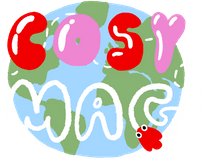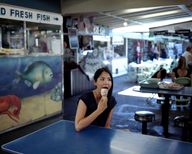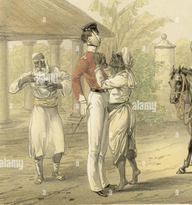“Say thank you,” my mother instructed, and I immediately obliged, even though we were Taiwanese. I was only a kid, but I knew this was weird. They were giving me compliments, but they were all based solely on my looks. And they were saying I was different. And I didn’t want to be different.
I showed my mother a photo of what I wanted to look like. We were one of the very few non-white families living in a small, New Jersey suburb, and I wanted to be like the blonde girls I saw in Bon Jovi videos.
I couldn’t understand why, no matter how many pumps of hair spray I put in my bangs, they wouldn’t stay up. My mom squinted at the photo I cut out of Tiger Beat, then at me, and confidently informed me (having zero hair expertise) that I needed a perm.
Two towns over, on the outskirts of the Paramus Park Mall, we visited a woman I had never met before but was required to call “Ayi” (Chinese for “Auntie”).
Ayi’s kitchen smelled like rotten eggs have gone chemical, and her sink had a short, attached garden hose amongst the dirty dishes. I sat cramped for hours on a phone book, getting what Ayi called “a body wave.” I was mortified by my third-grade class photo, taken one week later. It was my first lesson in not messing around with my natural hair. It was my introduction to the torture of what it takes to be beautiful.

After the perm mellowed out, I embraced my Asian roots, quite literally. I experimented once in college with a streak of blonde upon discovering Riot Grrrl bands, but for the most part, I’ve had the same hairstyle my entire teenage and adult life: long, straight, and pitch black.
I work as an actress, so whenever I’m on set they curl it to add texture — otherwise my slippery locks end up in my face, usually stuck to my lip colour. I grew proud of my mane, feeling a sense of security in its strength and reliability. When I wasn’t working, I loved how low maintenance my routine was. I didn’t have to think about it, and I appreciated that.
I am a feminist and this is scary to say out loud: It feels pretty good to have a job that’s based on my appearance. I love that I have a professional excuse to get my hair done, my nails manicured, my clothes tailored. That there is an army of professionals to help me do so, and that I am paid well for it.
The relief that comes the second I’m off duty, when I scrub off the layers of foundation, remove two dozen bobby pins from my head, and peel off the Spanx, isn’t just physical. It’s emotional. The expectation to look a certain way is there if I want to address it, but I feel the power in choosing not to in my everyday life.
One day, on the set of a web series, the grey hairs appeared. Suddenly, my crowning glory became my ultimate shame.
“Don’t pluck those,” the hairstylist who found them instructed me. I didn’t listen, and by the time we began filming the second season the following year, he informed me they had sprouted into several patches.
I could easily cover them up with black hair powder, but the time to start colouring my hair regularly had arrived. Once again, I had to think about what to do with my hair. It became a problem I had to fix. And I hated that.
About a month ago, we had a socially distant dinner with my husband’s family. It was dark outside, but even in the pale moonlight, I could tell that our Gen Z cousin’s naturally brown hair was significantly blonder. She told me she had been using something called Sunbabe which sounded a lot like a modernized version of Sun-In — a hair lightening spray activated by heat, like the sun or a hairdryer. The same stuff my high school classmates used that turned their hair orange.
I spent the next few days scrolling through the Sunbabe Instagram account — mostly women half my age, in bikinis, holding the small bottles in a hashtag sponsored, but not actually #sponsored pose. The images began to keep me up at night and so did the thoughts in my head:
I want this spray! DO NOT BUY THIS SPRAY. There is no way that $32 bottle and some sunshine is going to do what a professional is trained to do.
I tried to find some third-party reviews. There is very little written about Sunbabe online, though there are plenty about other, similar hair lightening sprays made by Sun Bum, Klorane, and John Frieda. Even Kristin Cavallari of Laguna Beach fame has one.
There were plenty of tutorials on making your own hair lightening concoctions using lemon juice and chamomile. Most of what I found was written by white women. Not all of them were thrilled with the results.
I finally admitted to a fellow Asian friend that I was thinking of becoming a “Sunbabe.” She put it to me straight:
“You’re not a 20-something influencer comfortable posting photos in a bikini. I can hear that you are barely comfortable uttering the words ‘Sunbabe.’ You don’t even wear bikinis. Also, you are an Asian woman in her 40’s. This spray was not made for you.”
And with that speech, I was brought back to third grade, sitting in Ayi’s kitchen salon, praying for the promise of acceptance based on my looks, thwarted by Asian genes. I wanted it to come easily, as simple as spritzing my tresses and lying on a towel in the sun.
I didn’t want to be reminded that I am getting older, that life is getting harder, and that quarantine makes everything a challenge.
Here’s where you might expect me to say that I decided not to buy the Sunbabe and that I finally accepted who I am, grey hair and all!
But that’s not what happened.
I bought the lightning spray, which took several weeks to arrive from Canada. I promised my friend who monologued her premonition that I would only test a strand.
But the second that bottle arrived, I doused my entire head in it with reckless abandon, just like a hormonal teenager. Then I sat in my driveway (sans SPF) for over an hour, in the middle of a Los Angeles heatwave.
And maybe here is where you expect me to say that it turned my hair orange and that I got a horrible sunburn to boot. That I relearned a valuable lesson from childhood. Well, that isn’t true, either.
By the fifth application, the peroxide had changed its texture into something Bon Jovi himself would be jealous of. I had taken an enormous gamble, and it had paid off.

Yet, despite all of this, I don’t think I’m going to purchase another bottle. Here is why:
I am realizing I still feel the same way as I did before the Sunbabe arrived.
It did not cure my anxiety or my depression. Maybe I wanted a little risky drama because I wanted to distract myself from the more serious events that occupy my mind every time I turn on my phone.
Or maybe I just wanted to buy into the belief, once again, that making my hair look non-Asian would make me feel accepted as an American.
Our country is going through some serious transformations when it comes to race and identity. COVID-19 and the violence against Asian-Americans is something I’ve carried with me in the back of my mind since March.
My niece, who is hapa (half Asian, half white) recently celebrated her tenth birthday. On Facebook, there were photos of her looking so much like I did at her age, only her Irish/Italian roots give her caramel highlights with soft, natural waves. My lifelong hair goals.
I thought of the message she would get if she heard me fawn out loud over her looks, and how she is probably only a few years away from owning a smartphone and receiving targeted ads like Sunbabe.
And if she wanted to drastically change her looks, I honestly don’t know how I’d respond.















